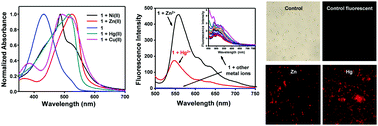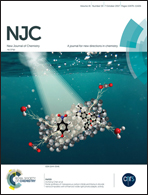Pentafluorophenyl dipyrrin as probe for transition metal ion detection and bioremediation in Bacillus subtilis and Bacillus cereus†
Abstract
We report a highly sensitive and selective “turn-on” fluorescent/colorimetric probe, 5-(pentafluorophenyl)dipyrrin (1), for selected transition metal ions in aqueous medium at biological pH. The limit of detection for Zn(II), Hg(II), Cu(II) and Ni(II) is found to be 0.18 μM, 0.28 μM, 13.01 μM and 18.31 μM respectively. The mechanism of complexation is confirmed as a 1 : 2 ratio of metal to ligand by Job's plot analysis and mass spectrometry. The practical application of the probe in bioremediation of metal ions by B. subtilis (BS) and B. cereus (BC) is demonstrated and the tolerance level of these microorganisms against metal ions is identified. The emission peak centered at a long wavelength of 548 to 558 nm indicates the potential application of this probe in bio-imaging Zn(II) and Hg(II) by fluorescence microscopy. Thus, it is possible to track the ions absorbed by BS and BC.



 Please wait while we load your content...
Please wait while we load your content...